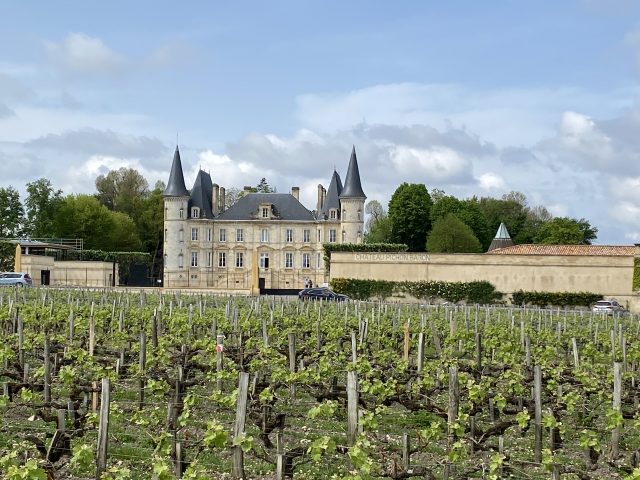En primeur 2021 by appellation: Pauillac, ‘a mixed bag’
Pauillac in 2021 is something of a mixed bag. There are undoubtedly great wines to be found here – some of the greatest of the entire vintage. But my gut feeling that this is not a great vintage for Pauillac nonetheless.

In no less trying and testing conditions, the producers of Margaux and St Julien it seems to me have typically fared better in relation to the quality of their terroirs. So, yes, many of 2021’s star turns come from Pauillac. But that Pauillac has so many great wines in the vintage seems to me to be more of a reflection of the quality of its terroirs and its size than any particular deftness in handling the compound climatic challenges of the growing season.
| 2018 | 2019 | 2020 | 2021 | 10-year average | Relative to 10-year average | |
| Margaux | 37.4 | 49.2 | 36.3 | 38.6 | 41.2 | -6.3 |
| St Julien | 42.6 | 45.5 | 34.3 | 35.2 | 41.8 | -15.8 |
| Pauillac | 38.5 | 46.7 | 37.4 | 35.1 | 41.5 | -15.4 |
| St Estèphe | 44.6 | 49.7 | 41.2 | 40.7 | 45.3 | -10.2 |
Table 1: Average vineyard yield by appellation (hl/ha)
Source: calculated from Duane/CIVB Service Economie et Etudes
That said, the data do suggest that Pauillac suffered marginally more than its Médocain neighbours – with a final average vineyard yield just below that of St Julien at 35.1 hl/ha. However, the difference is fractional and the 15.4% loss relative to the ten-year average is actually smaller than that suffered in St Julien.
But all of this may be to miss the point. For it would be wrong to assume a strong (or even, in fact, a positive) correlation between final yield in the vineyard and the quality of the grand vin itself. What is striking is how many of the leading wines of the appellation (on the very best terroirs) were produced from tiny yields, well below the appellation average (even before a typically ultra-strict selection for the grand vin itself). Latour and Pichon Baron harvested just 22 hl/ha and Pichon Comtesse de Lalande (30 hectares of which was farmed biodynamically for the first time) a derisory 15 hl/ha. Each, to be clear, has produced a truly great wine.
More significant it seems is the proportion of Merlot in the final blend. Time and again, and without noticing it particularly as I tasted, the wines that I have rated most highly turn out to be those with the least Merlot. Put more positively, the great wines of Pauillac, in 2021 above all, are massively reliant on Cabernet Sauvignon (in some cases augmented by Cabernet Franc). Pichon Comtesse de Lalande is 98% Cabernet (Franc and Sauvignon combined); Lafite and Latour are 96% Cabernet Sauvignon, whilst Mouton and Haut-Bages Libéral are both 90% Cabernet. Indeed, of the great Pauillacs of the vintage, Lynch Bages is the exception – with 25% Merlot – and ‘just’ 70% Cabernet.
The pick of the bunch, and certainly a candidate for left-bank wine of the vintage, is Lafite Rothschild, a wine that seems to expresses more fully than any other the cool summer Cabernet classicism of the vintage (though, interestingly, Duhart-Milon is stylistically very close in its more delicate, cool, calm austerity).
Mouton Rothschild, too, has made a truly fabulous wine – searingly fresh, breath-takingly energetic and, as a consequence, a little different in style to what one might have anticipated. I am a fan. Latour, too, is excellent; if, at this very early stage, more reticent and restrained.
Partner Content
Lynch Bages has, for me, made the strongest wine in the context of the vintage that I have ever tasted from here. The added precision from the new wine-making facility is much in evidence in a wonderfully detailed and pixilated mid-palate. It provides serious competition for the neighbours across the D2, Pichon Baron and Pichon Comtesse de Lalande – though both, too, have excelled despite the challenges of a most trying vintage. I find them ever so slightly more convergent in style than in recent vintages and Pichon Baron, especially, better than ever.
Finally, I would highlight the sheer quality and classicism of Grand-Puy Lacoste and the vivid and vibrant exuberance of Haut-Bages Libéral – a wine that seems to reflect almost perfectly the passion and brilliance of its proprietor, Claire Villars-Lurton.
Highlights in 2021
Best of the appellation:
- Lafite Rothschild (96-98)
Truly Great
- Duhart-Milon (92-94+)
- Grand-Puy Lacoste (93-95)
- Latour (94-96+)
- Lynch Bages (94-96)
- Mouton Rothschild (95-97)
- Pichon Baron (94-96)
- Pichon Comtesse de Lalande (94-96)
Value picks:
- Fonbadet (90-92+)
- Haut-Bages Libéral (92-94+).
For full tasting notes, see here.
See here for db’s en primeur vintage report , with appellation-by-appellation reviews on Margaux, St Julien, Pessac-Leognan & Graves red and blanc, St Estephe & Haut-Medoc, Pauillac, Pomerol, St Emilion and Sauternes.
Related news
For the ninth day of Christmas…




